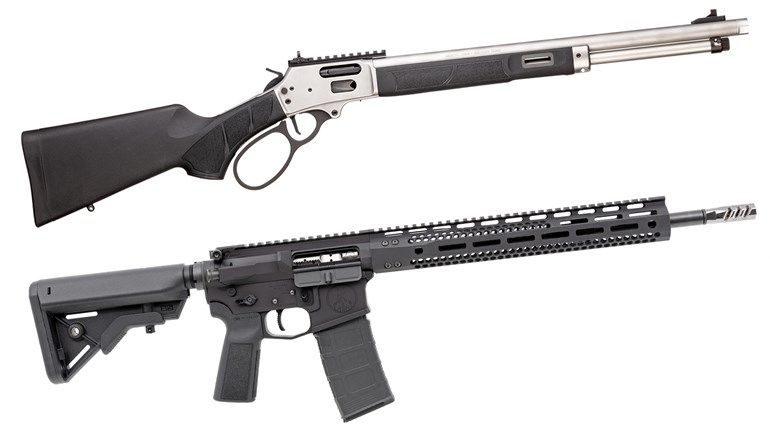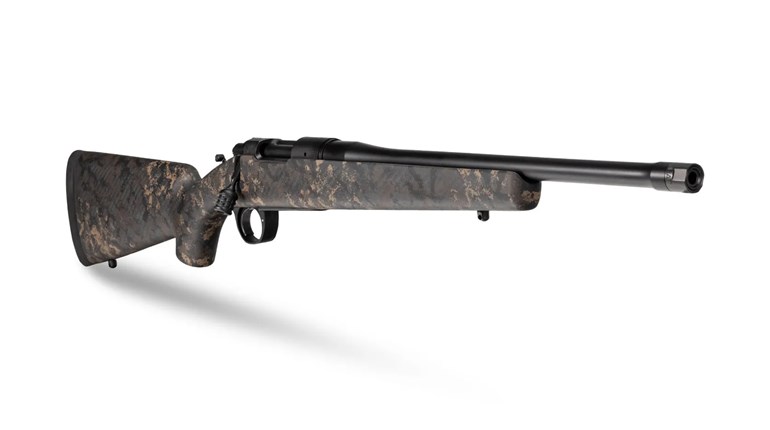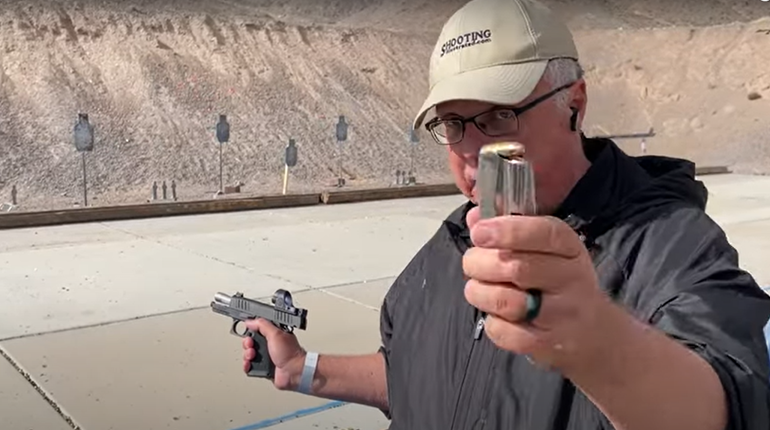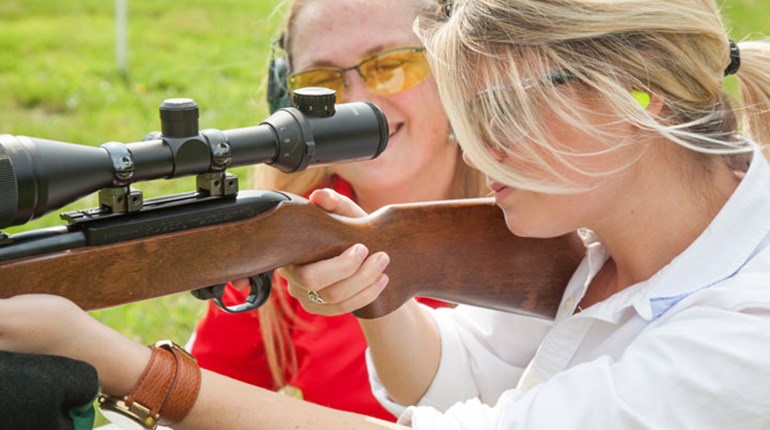
Thompson/Center’s new Dimension switch-barrel bolt-action looks quite different from most rifles on the market. For one thing, unlike a politician’s, the Dimension’s assets aren’t hidden. One of the first things you notice, other than the stock’s modern, stylized lines, is a big cog jammed against the front of the receiver that serves as the nut for the removable barrel. This torque collar (as T/C calls it) slides over the steel barrel extension to marry with a matching set of threads on the anodized aluminum receiver. After unscrewing two bolts in the stock to remove the receiver, loosening this nut is all it takes to disassemble the Dimension for the barrel-switching process.
To change calibers, simply slide the appropriately chambered barrel into the receiver, making sure to mate a small notch on the underside of the receiver with an indexed pin on the barrel. Then screw down the torque collar with the included two-piece Locking Optimized Components (LOC) tool, a combination torque wrench/Allen wrench that ensures the entire assembly is tightened together correctly and safely.
A quick note about calibers: T/C has grouped them into four families depending on action length: “A” (.204 Ruger, .223 Rem.), “B” (.22-250 Rem., .243 Win., 7mm-08 Rem., .308 Win.), “C” (.270 Win., .30-06) and “D” (7mm Rem. Mag, .300 Win. Mag.). If you stay within a family when swapping calibers, only the barrel needs to be changed. If the new barrel is chambered in something other than the original barrel’s family, you’ll also need to swap magazine inserts and bolts before screwing the action into the stock. Each accessory is clearly marked with its family designation, so there’s little chance of accidently mixing and matching bolts and magazines. And if you do, T/C designed the bolt/barrel combination to only function within its family.
The company claims the whole barrel-swapping process takes just two minutes from start to finish. I will say it is simple enough that with minimal instruction even the most mechanically averse user can do it quickly, but after two months of shooting the gun, the best time I was able to achieve was just less than three minutes, which is still pretty impressive. My biggest beef with the design is the difficulty removing the bolt with the gun assembled. I found it nearly impossible to do without marring the polypropylene stock, despite the presence of a milled notch in the front of the comb that’s designed to prevent just such a thing from happening.
After a few dates with the Dimension on the bench, I skipped prom altogether and jumped right into the honeymoon phase on a 10-day safari to South Africa. For the trip, I chose calibers at opposite ends of the spectrum: a 7mm Rem. Mag. for big, tough African animals like kudu and gemsbok, paired with a .223 Rem. from the “A” family to shoot smaller plains game like springbok and impala, as well as any varmints we might encounter. The barrels were topped with Zeiss optics—a Conquest 3.5x-10x with Rapid Z reticle for the magnum, a Duralyt 3x-12x on the .223—and stuffed with Hornady Superformance ammo.
The hunt was a free-range affair with Crusader Safaris, located up the Baviaans River in the Eastern Cape province. This is big country, home to vast sheep ranches and not much cover. Before the trip, we were warned that long shots would be the norm and to practice accordingly. In fact, average shot distance on the nine animals I tagged during the hunt was 243 yards, the farthest being a 400-yard poke with the .223 that dropped a cull springbok where it stood. With the exception of my gemsbok, which got an insurance round, all were taken with just a single shot, a testament to both the accuracy of the gun and the performance of the Hornady loads.
The trigger is the same unit used in T/C’s Icon bolt-action; it’s single-stage, with pull weight adjustable between 3.5-5 pounds. Under controlled conditions, T/C guarantees every chrome-moly, 5R-rifled Dimension barrel will put three shots inside an inch at 100 yards. With a couple of exceptions, my 7mm barrel had trouble breaking into that 1-inch circle when shooting from sandbags on my outdoor range. It was, however, consistent in its accuracy and, interestingly, groups tightened as the barrel warmed. The .223 barrel proved to be a laser with just about any ammo I stuffed into it; my best group measured .34 inch.
While MOA accuracy is nice, the real foundation of the Dimension’s reputation, and that of any switch-barrel gun, is repeatability—the ability to stay on target between barrels. That’s where the Dimension really impresses, especially at the gun’s $700 price. To test this, I fired a three-shot group with each caliber, switching barrels between every shot. Both did a more-than-fair job of maintaining original point of impact, with groups measuring 1.59 inches in the .223 and 1.41 inches in 7mm Mag.
The Dimension comes with a set of Weaver-style mounts for those wishing to use a single scope on the rifle, but to get this kind of repeatable accuracy without the need to re-zero when swapping barrels, T/C offers an optional bridge mount. The elevated rail mounts onto the barrel just ahead of the torque ring and is secured to a separate base on the receiver via a single captured screw. (Both stock screws are also fully captured, eliminating the chance of losing one in the field.) When swapping a barrel-scope combination, just loosen this rear screw before continuing with the rest of the disassembly process.
All that leaves us with is the black polypropylene stock, which is what drives the more shallow shooters among us into fits. For some reason, they can’t see the forest for the trees, claiming the swooping line of the buttstock is visually jarring and the free-floating barrel hangs above the fore-end, to paraphrase one noted gun-writer, “like the Hindenburg.” As for the first argument, the lines may be untraditional, but the gun is comfortable to carry and surprisingly shoulder-friendly, even when shooting heavy magnum calibers. The gap between the fore-end and a standard-contour barrel also trumps form with function, leaving enough space to accommodate a bull barrel.
The design and function of this new rifle platform is not for everyone, just those who are confident enough to show up in hunting camp with a gun that, while not the norm, carries with it something intangible. In the case of the Dimension, that something is performance, offering switch-barrel versatility backed by Thompson/Center’s sterling reputation for accuracy.
Technical Specifications:
Type: switch-barrel, bolt-action centerfire, repeating rifle
Caliber: .204 Ruger, .223 Rem. (tested), .22-250 Rem., .243 Win., 7mm-08 Rem., .308 Win., .270 Win., .30-06, 7mm Rem. Mag. (tested), .300 Win. Mag.
Barrel: standard calibers 22", magnums 24"; 5R rifling, 1:9"-1:12" twist depending on caliber
Trigger: single-stage, pull weight adjustable from 3.5-5 lbs.
Magazine: detachable, single-stack, polymer, 3-rnd. cap.
Sights: none; drilled/tapped, Weaver bases factory-installed
Safety: two-position
Stock: Monte Carlo style; synthetic; LOP adjustable from 12.5"-13.5"
Overall Length: 41.75"-43.75"
Weight: 7 lbs.
Metal Finish: blued
Accessories: LOC torque tool, Weaver scope bases
MSRP: $679 (extra barrels $250; extra bolts $162; bridge scope mount $88)





































